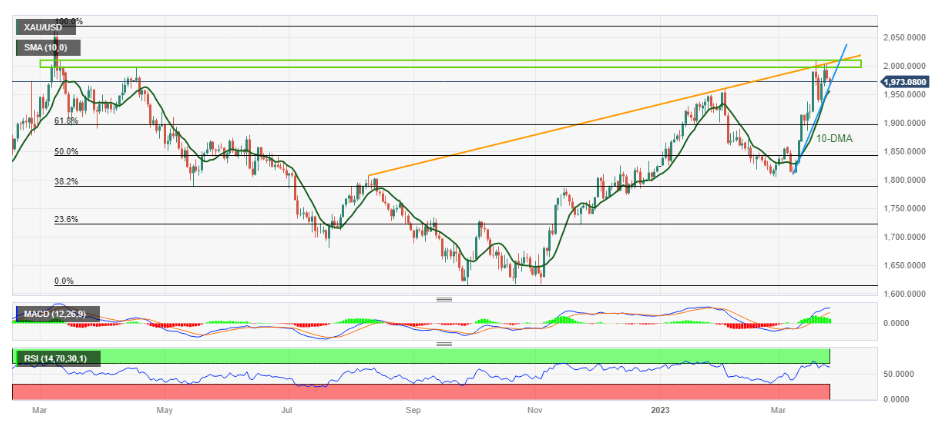
During the European session on Monday, gold fell below $1970, recording two consecutive losses. Gold prices fell from the $2,000 mark as U.S. authorities assured investors of their firm commitment to addressing any potential problems in the banking sector. First Citizens Bank of America has agreed to buy a large stake in Silicon Valley Bank (SVB).
The firm commitment from the U.S., along with a slightly stronger dollar and a recovery in stock markets, contributed to gold's decline. The move in the precious metal also confirmed the latest rebound in U.S. Treasury yields, while extending a U-shaped reversal from a key resistance area the day before. However, gold prices may continue to find support from major macroeconomic events, such as potential risks in the banking sector.
A recent surge in Deutsche Bank's credit-default swaps has reignited investor concern over the incident, prompting investors to turn risk-averse on Friday. While there's no definitive evidence that Deutsche Bank has any real problems, concerns that the country's banks are undercapitalized could lead to gains in gold prices.
At a policy meeting last week, Federal Reserve officials noted no signs of worsening financial stress, allowing them to focus on lowering inflation through further rate hikes. The Federal Reserve raised interest rates by 25 basis points, as expected, while signaling an imminent pause in rate hikes. Kashkari and other Fed officials expressed confidence in the stability and resilience of the U.S. banking system, while stressing that inflation remains a priority.
In addition, as one of the world's largest gold consumers, China's economic growth rate, together with the previous day's hawkish Fed talk and most of the US data, put pressure on the recent trend of gold prices.
In terms of geopolitical risks, Russian President Vladimir Putin announced that he will place tactical nuclear weapons in Belarus and transport 10 aircraft capable of carrying such weapons to Belarus. Putin said the move would not violate the nuclear nonproliferation agreement and that Russia would station the weapons in Belarus, similar to what the United States does in Europe. The North Atlantic Treaty Organization (NATO) and the United States criticized the decision, saying it was dangerous and irresponsible, but the United States also believes that Russia is not prepared to use nuclear weapons. A further escalation in the situation could boost gold prices as it would boost safe-haven demand.
Separately, International Monetary Fund (IMF) Managing Director Kristalina Georgieva warned that "risks to financial stability have increased," testing gold bears. Likewise, comments were also made by Minneapolis Fed President Neel Kashkari, who flagged concerns about a U.S. recession.
Affected by this, the U.S. dollar index recorded a three-day gain, near 103.12, as traders awaited important inflation data on Friday, mainly the core U.S. consumer spending price index for February. The PCE index is expected to have risen 0.4%, a slowdown from January's 0.6%. The annual rate of the core PCE price index is expected to slow to 4.3% from 4.7%. The release of the data could affect gold prices and market sentiment as investors keep an eye on inflation trends and their potential impact on the economy and financial markets.
U.S. 10-year yields rose 2 basis points to 3.40%, while 2-year yields snapped a three-day losing streak to near 3.85%.
Looking ahead, gold prices remain bearish due to failure to break key resistance levels and based on month-end consolidation. Gold traders, however, will focus on the Fed's preferred inflation gauge due out on Friday.
Gold Technical Analysis
Gold prices continued the callback from the key resistance level the day before, and continued to focus on the confluence of support near $1955, which includes the 10-day moving average and the 13-day rising trend line.
Not only did the price of gold fail to break through the broad resistance area between 2020-1998 dollars, the MACD bullish bias weakened and the RSI retreated from the overbought area, which also favored gold bears.
Notably, the previous month's high of $1,960 acted as short-term support.
A break below $1,955 would see gold testing key support at $1,935, the 38.2% retracement level and the confluence of the March 21 and 22 highs.
If it falls further, the price of gold does not rule out the possibility of falling to around $1,896, the 61.8% retracement of the decline from March to September 2022.
Meanwhile, the confluence of last year's multiple tops and an ascending resistance line from August 2022 around $1998-2010 constitutes a key resistance level that, if breached, would allow the bulls to regain control.
After that, the price of gold may rise to the previous year's high of $2,070.
Spot gold daily chart

JRFX shares news information and professional technical analysis on foreign exchange, spot gold or crude oil every trading day. Follow us so as not to miss the market focus of the day and grasp the trading market in time.
JRFX reminds you: the market is risky, and investment needs to be cautious. This article does not constitute personal investment advice. Please choose corresponding investment products according to your own financial and risk tolerance, and do a good job in corresponding risk control.
About JRFX
· 12 years of financial market experience, the choice of more than 4 million customers, one of the most respected foreign exchange brokers in the world
· Provide 50+ trading products, including foreign exchange, spot gold, crude oil, stocks, indices, cryptocurrencies, etc.
· Three trading accounts to meet the investment needs of different customers
· Zero commission, low spread, leverage up to 1:1000
· You can open an account with a minimum deposit of 100 US dollars only